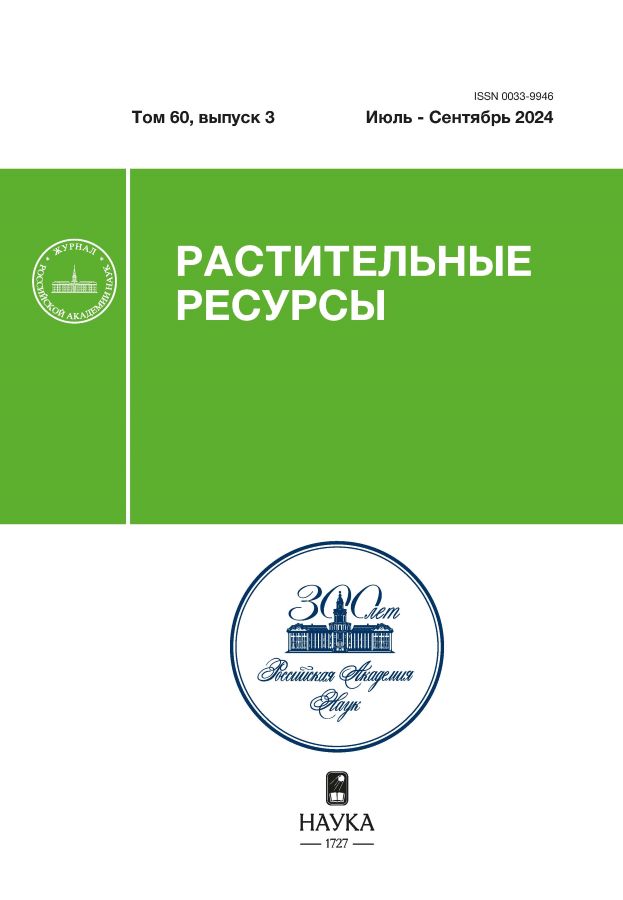Features of the elemental composition of some Lake Baikal macrophytes
- Authors: Belykh O.A.1
-
Affiliations:
- Kaliningrad State Technical University
- Issue: Vol 60, No 3 (2024)
- Pages: 111-121
- Section: Component Composition of Resource Species
- URL: https://ruspoj.com/0033-9946/article/view/674405
- DOI: https://doi.org/10.31857/S0033994624030086
- EDN: https://elibrary.ru/PTPWOE
- ID: 674405
Cite item
Abstract
The content of 21 chemical elements in four types of macrophytes collected on the coast of Lake Baikal in the Irkutsk region in 2020–2021 was studied. The article discusses the features of the elemental composition of biogenic elements and the accumulation of heavy metals in higher aquatic plants growing in the bays, which experience high summer recreational pressure. In summer, macrophytes of the lake Baikal perform the function of a natural biofilter, depositing biogenic elements and toxic substances from the catchment area. The studied species of Potamogeton pectinatus L., Potamogeton perfoliatus L., Myriophyllum spicatum L., Polygonum amphibium (L.) S.F. Grey., Elodea canadensis Michx can serve as indicators of eutrophication of water bodies. It was established that no excess of MPC was observed in the objects of study. The experiment can serve as a justification for the use of the XRF method (X-ray fluorescence analysis) as a means of monitoring the state of coastal ecosystems. The results of the study are important for creating an information base for chemical monitoring and decision-making to prevent the negative consequences of tourism and the environmental safety of Lake Baikal.
Full Text
About the authors
O. A. Belykh
Kaliningrad State Technical University
Author for correspondence.
Email: olga.belykh@klgtu.ru
Russian Federation, Kaliningrad
References
- State report «On the state and protection of the environment in the Irkutsk region: 2021». https://irkobl.ru/sites/ecology/2954%20Иркутск%20Природа%20Макет.pdf (In Russian)
- Krivina E. S., Tarasova N. G. 2018. Changes in the taxonomic structure of phytoplankton inhabiting small water bodies as a consequence of the technogenic impact. – Uchenye zapiski Kazanskogo universiteta. Seriya: Estestvennye nauki. 160(2): 292–307. https://www.elibrary.ru/item.asp?id=35740605 (In Russian)
- Antsiferova G. A., Rusova N. I., Shevyrev S. L. et al. 2020. Transformation of natural water bodies as a standard of the state of aquatic ecosystems of specially protected and urbanized territories. – Proceedings of Voronezh State University. Series: Geography. Geoecology. 4: 53–60. https://doi.org/10.17308/geo.2020.4/3065
- Azovskij M. G., Chepinoga V. V. 2007. [Flora of the higher plants of Lake Baikal]. Irkutsk. 157 p. (In Russian)
- Lebedeva O. A., Garin E. V., Belyakov E. A. 2015. The formation of land forms in Batrachium circinatum (Sibth.) Spach. (Ranunculaceae Juss.) under conditions of fluctuating water levels. – International Journal of Applied and Fundamental Research. 12(8): 1442–1444. https://applied-research.ru/en/article/view?id=8169 (In Russian)
- Verkhozina V. A., Belykh O. A., Verkhozina E. V. 2022. Changes in the bacterial community in the littoral zone of the ecosystem of the southern part of Lake Baikal under the influence of anthropogenic load. – Bulletin of Baikal State University. 32(2): 397–406. https://doi.org/10.17150/2500-2759.2022.32(2).397-406 (In Russian)
- Kvesitadze G. I., Khatisashvili G. A., Sadunishvili T. A. 2005. [Metabolism of anthropogenic toxicants in higher plants]. Moscow. 199 p. (In Russian)
- Belykh O. A. 2014. [Ecological monitoring of grass cover in Southern Siberia]. Irkutsk. 150 p. (In Russian)
- Belykh O. A., Glyzin L. A., Konstantinova E. A., Glyzina O. Yu. 2019. Filtration capacities of Lubomirskia baicalensis biocenosis in condition of a model experiment. – Bulletin of Baikal State University. 29(2): 179–184. https://doi.org/10.17150/2500-2759.2019.29(2).179-184 (In Russian)
- Ali S., Abbas Z., Rizwan M., Zaheer I. E., Yavaş İ., Ünay A., Abdel-Daim M. M., Bin-Jumah M., Hasanuzzaman M., Kalderis D. 2020. Application of floating aquatic plants in phytoremediation of heavy metals polluted water: A review. – Sustainability. 12(5): 1927. https://doi.org/10.3390/su12051927
- Chuparina E. V., Martynov A. M. 2011. Application of non-destructive X-ray fluorescence analysis to determine the elemental composition of medicinal plants. – J. Analyt. Chem. 66(4): 389–395. https://doi.org/10.1134/S106193481104006X (In Russian)
- Zhigzhitzhapova S. V., Dylenova E. P., Nikitina E. P. et al. 2022. Heavy metals and fatty acid composition of Ranunculus circinatus (Sibth.) Spach (Ranunculuaceae) from the delta of the Selenga River. – Khimiya Rastitel'nogo Syr'ja. (40): 171–179. https://doi.org/10.14258/jcprm.20220411286 (In Russian)
- Alekin O. A., Semenov A. D., Skopincev B. A. 1973. [Rukovodstvo po himicheskomu analizu vod sushi / Gl. upr. gidrometeorol. sluzhby pri Sovete Ministrov SSSR. Gidrohim. in-t]. 3-e izd. Leningrad. 269 p. (In Russian)
- Grebenshchikova V. I., Kuzmin M. I., Demyanovich V. M. 2024. Different dynamics of the chemical composition of water in the Baikal ecosystem (Baikal, its tributaries, and the source of the Angara River. – Russ. Geol. Geophys. 65(3): 353–365.https://doi.org/10.2113/RGG20234650
- Kanickaya L. V., Mokryy A. V., Belykh O. A., Smirnova E. V. 2015. Environmental assessment of Baikalsk Area rivers for tourism and recreation development. – Fundamental Research. (7–3): 463–467. https://fundamental-research.ru/en/article/view?id=38759 (In Russian)
- [Criteria for assessing the environmental situation of territories to identify zones of ecological emergencies and disasters (approved by The Ministry of Natural Resources of the Russian Federation on 30.11.1992)]. https://docs.cntd.ru/document/901797511 (In Russian)
- Zhigzhitzhapova S. V., Pavlov V. G., Shiretorova V. G. et al. 2019. Metal content in aquatic plants of Lake Gusinoe. – Water: Chemistry and Ecology. 1–2: 34–40. https://elibrary.ru/item.asp?id=37613772 (In Russian)
- Kabata-Pendias A., Pendias H. 1989. Trace elements in soils and plants. Moscow. 439 p. Transl. from English. (In Russian)
- Ilyin V. B., Syso A. I. 2001. [Trace elements and heavy metals in soils and plants of the Novosibirsk region.]. Novosibirsk. 229 p. (In Russian)
- Manasypov R. M., Kirpotin S. N., Pokrovsky O. S., Shirokova L. S. 2012. Features of the elemental composition of lake waters and macrophytes in thermokarst subarctic ecosystems of Western Siberia. – Tomsk State University Journal of Biology. 3(19): 186–198. https://elibrary.ru/item.asp?id=18037927 (In Russian)
Supplementary files












